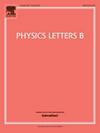Thermodynamic topology, photon spheres, and evidence for weak gravity conjecture in charged black holes with perfect fluid within Rastall theory
IF 4.5
2区 物理与天体物理
Q1 ASTRONOMY & ASTROPHYSICS
引用次数: 0
Abstract
This study explores the Weak Gravity Conjecture within the framework of charged black holes surrounded by a perfect fluid, analyzed under Rastall theory. A key focus is the behavior of photon spheres, which serve as critical indicators of whether these objects qualify as true black holes or devolve into naked singularities. The investigation sheds light on the deep interplay between quantum forces and gravity, pointing toward new links between high-energy physics and alternative theories of gravity. We find that the structure of these black holes is highly sensitive to variations in the intensity of the surrounding fluid and the parameters specific to Rastall gravity. In the case of a dust-like environment, the black hole satisfies the conditions required by the Weak Gravity Conjecture (WGC) when it reaches an extremal state, and the existence of a photon sphere confirms its black hole nature. However, pushing the gravitational parameters further or weakening the fluid intensity can lead to the disappearance of the photon sphere, signaling a transition to a singularity rather than a black hole. The analysis extends to other types of cosmic fluids, including those representing radiation, quintessence, and phantom energy. Across various conditions, we identify scenarios where the Weak Gravity Conjecture continues to hold, reinforcing its broader applicability. Our numerical method reveal distinct regions in the parameter space where the conjecture is validated, offering insights that bridge quantum-scale physics with cosmological structures. Additionally, we examine the topological properties of these black holes using a theoretical approach that incorporates a generalized version of Helmholtz free energy and topological current theory. Our findings indicate that, regardless of the fluid type considered, the overall topological classification remains unchanged an show the behaviour of a classical black hole solutions (Reissner-Nordström black holes) with a total topological charges .
热力学拓扑学,光子球,以及拉斯托理论中具有完美流体的带电黑洞弱引力猜想的证据
本研究在带电黑洞被完美流体包围的框架下探索弱引力猜想,并在拉斯托理论下进行分析。一个关键的焦点是光子球的行为,它是这些物体是否有资格成为真正的黑洞或退化为裸奇点的关键指标。这项研究揭示了量子力和引力之间的深层相互作用,指出了高能物理和引力替代理论之间的新联系。我们发现,这些黑洞的结构对周围流体强度的变化和拉斯托引力的特定参数非常敏感。在类尘环境下,黑洞在达到极值状态时满足弱引力猜想(WGC)所要求的条件,光子球的存在证实了它的黑洞性质。然而,进一步推动引力参数或减弱流体强度可能导致光子球消失,这标志着向奇点而不是黑洞的过渡。该分析扩展到其他类型的宇宙流体,包括那些代表辐射、精粹和幻影能量的流体。在各种条件下,我们确定了弱引力猜想继续成立的场景,加强了其更广泛的适用性。我们的数值方法揭示了参数空间中验证猜想的不同区域,为量子尺度物理与宇宙结构之间的桥梁提供了见解。此外,我们使用结合广义版亥姆霍兹自由能和拓扑电流理论的理论方法来检查这些黑洞的拓扑特性。我们的研究结果表明,无论考虑哪种流体类型,总体拓扑分类保持不变,并显示出总拓扑电荷W=0的经典黑洞解(Reissner-Nordström黑洞)的行为。
本文章由计算机程序翻译,如有差异,请以英文原文为准。
求助全文
约1分钟内获得全文
求助全文
来源期刊

Physics Letters B
物理-物理:综合
CiteScore
9.10
自引率
6.80%
发文量
647
审稿时长
3 months
期刊介绍:
Physics Letters B ensures the rapid publication of important new results in particle physics, nuclear physics and cosmology. Specialized editors are responsible for contributions in experimental nuclear physics, theoretical nuclear physics, experimental high-energy physics, theoretical high-energy physics, and astrophysics.
 求助内容:
求助内容: 应助结果提醒方式:
应助结果提醒方式:


